Jay Wright's 4-out Motion Offense, Coach's Clipboard Basketball
By Dr. James Gels, from the Coach’s Clipboard Basketball PlaybookDisclosure: This page contains affiliate links, which means that Coach's Clipboard receives a small commission (at no cost to you) if you make a purchase using these links.
Hall of Fame basketball coach Jay Wright coached Villanova for over 20 years with multiple championships, including two NCAA Men's National Championships (2016 and 2018). He used a simple 4-out motion offense (with great players). I suspect that earlier in his career (judging from some earlier videos) he ran the 4-out similar to what is presented in 4-Out, 1-In Motion Offense.
But he modified it so that instead of 4 guards and a post player, he used 3 guards and two "forwards" (posts) with one of the forwards always occupying a perimeter slot, hence 4-out. Using two "bigs" helps with rebounding and defensive match-ups.
His rules are fairly simple and could easily be used at the high school level.
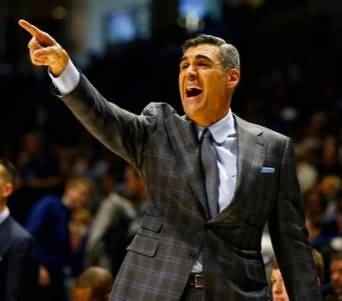
Former Villanova Coach Jay Wright
Coach Wright's 4-Out Rules
4-Out Spots
Forwards:
Diagram 1 shows the 4 spots that can be occupied by the forwards (O4 and O5). There are two mid-post spots and two "slot" spots at the top. The "slots" are defined as the two spots at the 3-point arc, lane line extended. The two forwards are always "hi-lo opposite", meaning if one is at the right mid-post, then the other is at the left slot position, and vice versa. This results in good spacing.Notice in diagram 3, if O4 cuts inside to the right mid-post, then O5 moves up to the left slot and O1 dribbles to fill the right slot.
Guards:
Diagram 2 shows the four guard spots, the two slots and two wing spots.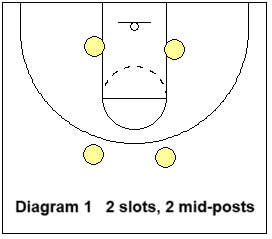

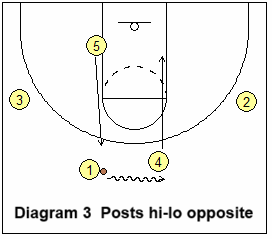
Motion rules
Guards:
After passing, guards can (1) basket cut, (2) screen or (3) use a screen.Guards can only screen for each other, never for a forward. So the only time guards can set a screen is when two guards are on the same side of the floor, which could be a either flare screen or a down-screen (see below).
Guards basically are cutters, while forwards are screeners.
Forwards:
Forwards are screeners but only screen for guards, and they screen at the slot positions. Forwards never screen for each other.Diagram 4 - O1 passes to O2. O5 screens at the slot for O1. Here, O1 basket-cuts, but O5 could also set this slot screen as a flare screen for O1. As O5 moves to set the right slot screen, O4 slides across to the left mid-lane spot (hi-lo opposite rule).
Another rule is "leave a spot, fill a spot". So now looking at diagram 5, O1 did not get the pass and cuts out to fill the left wing as O3 fills the left slot.
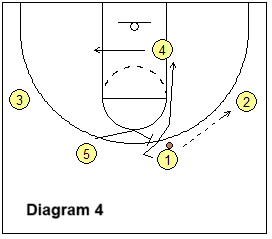

Again, guards can only screen for each other, never for a forward. And the only time a guard can screen is when there are two guards on the same side of the court.
Diagram 6 shows a down-screen with O3 screening for O1. O5 could also screen the left slot for O1, resulting in a double staggered screen and a basket cut by O1 for the pass from O2.
Diagram 7 shows a flare-screen with O1 screening for O3. O5 skip passes to O3 for the 3-pointer, or a pass into O4.

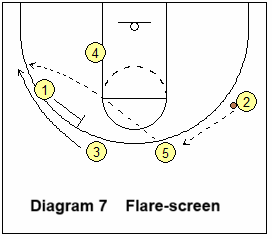
Again, guards can only screen for guards and forwards can only screen for guards (at the slots).
Those are the basic rules.
More Reading on the 4-Out Motion Offense
- 4-Out Motion Offense
- How to Use Your Post Player in the 4-Out Offense
- Quick Hitters for the 4-Out Offense
- 4-Out, 1-In Motion Offense "High" Plays
- 4-Out, 1-In Motion Offense "Low" Plays
- 4-Out Zone Offense